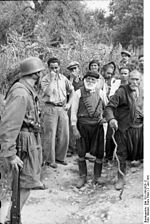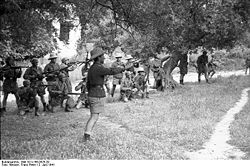- Massacre of Kondomari
-
The Massacre of Kondomari (Greek: Σφαγή στο Κοντομαρί) refers to the execution of male civilians from the village of Kondomari in Crete by an ad hoc firing squad consisting of German paratroopers on 2 June 1941 during World War II.[1] The shooting was the first of a long series of mass reprisals in Crete and was also the first mass execution of civilians during WW II.[2]. It was orchestrated by Generaloberst Kurt Student, in retaliation for the participation of Cretans in the Battle of Crete which had ended with the surrender of the island only two days earlier.
Contents
Background
Geography
The village of Kondomari is part of the Platanias municipality, being located near the north coast of Crete and 18 km west of the city of Chania. The village is in the vicinity of the Maleme airstrip, which is situated a mere 3 km to its northwest.
During the Battle of Crete
The Battle of Crete begun on 20 May 1941 with a large-scale airborne invasion aimed to capture the island's strategic locations. As was proven in practice, one of the most important such locations was the Maleme airstrip and its surrounding region. Its capture allowed the Luftwaffe to fly in large-scale reinforcements of troops and supplies that eventually determined the outcome of the Battle.
In the morning of 20 May 1941, German paratroopers of the III Battalion of the 1st Air Landing Assault Regiment were dropped southeast of Maleme. Their landing site extended to Platanias and included Kondomari. The invaders were confronted by the 21st and 22nd New Zealand Infantry Battalions, joined by ill-armed local civilians carrying primitive weapons. The paratroopers experienced strong resistance and suffered severe losses that totaled nearly 400 men, including their commander Major Otto Scherber. Eugen Meindl, the regiment's commander, was shot through the chest and had to be replaced by Oberst Hermann-Bernhard Ramcke.
Student's order on reprisals
Throughout the Battle of Crete, the Allied forces and Cretan irregulars had inflicted heavy losses of lives on the Wehrmacht. In particular, the unprecedented, valiant resistance from the local population exasperated the Prussian sense of military order according to which no one but professional warriors should be allowed to fight. Reports from General Julius Ringel, commander of the 5th Mountain Division, stated that Cretan civilians were picking off paratroopers or attacking them with knives, axes and scythes. Even before the end of the Battle, unproven and exaggerated stories had started to circulate, attributing the excessively high casualties to torture and mutilation of paratroopers by the Cretans.[3] When these stories reached the Luftwaffe's High Command in Berlin, Göring commanded Student to undertake inquiries and reprisals. Thus, seeking to counter insurgency and before inquiries were complete, temporary commander General Kurt Student issued an order for launching a wave of brutal reprisals against the local population right after the surrender of Crete on 31 May. The reprisals were to be carried out rapidly, omitting formalities or trials and by the same units who had been confronted by the locals.[3]
The massacre
Following Student's order, the occupants of Kondomari were blamed for the death of a few German soldiers whose bodies had been found near the village. On 2 June 1941, four lorries full of German paratroopers from the III Battalion of Luftlande-Sturm-Regiment 1 under the command of Oberleutnant Horst Trebes surrounded Kondomari. Trebes, a former member of the Hitler Youth, was the only key officer of the Battalion to have survived the Battle unwounded. Men, women and children were forced to gather in the village square. Then, a number of hostages was selected among the men while women and children were released. The hostages were led to the surrounding olive groves and later fired upon in cold blood.[4] The exact number of the victims is unclear. According to German records, a total of 23 men were killed but other sources raise the toll to about 60.[3] The whole operation was captured on film by Franz-Peter Weixler, then serving as a war propaganda correspondent (kriegsberichter) for the Wehrmacht.
Aftermath
The day following the massacre of Kondomari, forces of the 1st Air Landing Assault Regiment went on to commit yet another war crime, razing Kandanos and executing most of its populace.
After the summer of 1941, Franz-Peter Weixler was dismissed from the Wehrmacht for political reasons. Later on, he was accused of high treason for having leaked uncensored material related to the paratroopers' activities in Crete that included photographs taken in Kondomari, and for having helped some Cretans to flee.[3] Weixler was arrested by the Gestapo, court martialled and imprisoned from early 1944. In November 1945, during Göring's trial in Nuremberg, Weixler gave a written eyewitness report on the Kondomari massacre. His negatives from Kondomari were discovered in the German archives in the early 1980s and his photographs became widely known.
In July 1941, Horst Trebes was awarded the Knight's Cross for his leadership during the assault against Crete. Three years later (1944), he was killed in action in Normandy.[3]
After the surrender of Germany, Kurt Student was captured by the British. In May 1947, he came before a military tribunal to answer charges of mistreatment and murder of prisoners of war by his forces in Crete. Greece's demand to have Student extradited was declined. Student was found guilty of three out of eight charges and sentenced to five years in prison. However, he was given a medical discharge and was released in 1948. Student was never tried for crimes against civilians.
See also
External links
- Franz-Peter Weixler's testimony on the events in Kondomari
- Kondomari massacre from fallschirmjager.net with photos
- German occupation of Crete: Kondomari (in German -- translate)
References
- ^ Mazower, Mark. Inside Hitler's Greece: The Experience of Occupation, 1941-44, Yale University Press, 2001, ISBN 0300089236.
- ^ Richter, Heinz A., Operation Merkur. Die Eroberung der Insel Kreta im Mai 1941, Rutzen, 2011, ISBN 978-3-0447-06423-1
- ^ a b c d e Beevor, Antony. Crete: The Battle and the Resistance, John Murray Ltd, 1991. Penguin Books, 1992.
- ^ MacDonald, C.A. The lost battle--Crete, 1941. Free Press, 1993, ISBN 0029196256.
Greece during World War II 1940–41 Balkans Campaign Occupation and Resistance Greek government in exile Battles: Elaia–Kalamas · Pindus · Morava–Ivan · Klisura · Trebeshina · Italian Spring Offensive
Commanders:
 Greece
Greece
Ioannis Metaxas · Alexander Papagos · Charalambos Katsimitros
 Italy
Italy
Sebastiano Visconti Prasca · Ubaldo Soddu · Ugo Cavallero · Giovanni MesseBattles: Metaxas Line · Vevi · Kleisoura Pass · Thermopylae · Crete
Commanders:
 Greece
Greece
Alexander Papagos · Georgios Tsolakoglou
 British Expeditionary Corps
British Expeditionary Corps
Henry Maitland Wilson · Thomas Blamey · Bernard Freyberg
 Germany
Germany
Wilhelm List · Kurt StudentOccupying powersOccupation Authorities:
 Germany
Germany
Günther Altenburg · Hermann Neubacher · Walter Schimana · Alexander Löhr · Hellmuth Felmy
 Italy
Italy
Pellegrino Ghigi · Carlo Geloso
 Bulgaria
BulgariaAtrocities: Kondomari · Kandanos · Doxato · Kommeno · Kalavryta · Distomo · Domenikon · Drakeia · Cephalonia · Paramythia · Mesovouno · Pyrgoi · Viannos · Kedros · Chortiatis · The Holocaust in Greece · Great Famine
CollaboratorsPeople: Georgios Tsolakoglou · K. Logothetopoulos · Ioannis Rallis · Georgios Poulos
Organizations: Collaborationist government · Security Battalions · ESPO · EEE · Greek National Socialist Party
Secessionists: Principality of the Pindus · Ohrana · Cham collaboration (Këshilla)
People: Aris Velouchiotis · Stefanos Sarafis · Georgios Siantos · Markos Vafiades · Evripidis Bakirtzis · Andreas Tzimas
Organizations: KKE · ELAS · PEEA · EPON · E.A. · OPLA · SNOF
Operations: Ryka · Mikro Chorio · Gorgopotamos Bridge · Fardykambos · Sarantaporo · Kournovo Tunnel
Non-EAM ResistancePeople: Napoleon Zervas · Georgios Kartalis · Dimitrios Psarros · Komninos Pyromaglou · Alexander Papagos · Kostas Perrikos · George Psychoundakis
Organizations: EDES · EKKA · YVE/PAO · PEAN · ΕΟΚ · E.S. · MAVI · Other
Operations: ESPO bombing · Gorgopotamos Bridge · Fardykambos · Agia Kyriaki · Milia · Skala Paramythias · Xirovouni · Menina · Dodona
Atrocities: Expulsion of Cham Albanians
People: Eddie Myers · Chris Woodhouse · Patrick Leigh Fermor · Bill Stanley Moss
Operations: Operation "Albumen" · Gorgopotamos Bridge · Operation "Animals" · Asopos Bridge · Kidnap of General Kreipe · Damasta sabotage
Events: El Alamein · Dodecanese · April 1944 mutiny · Rimini
People: King George II · Emmanouil Tsouderos · Panagiotis Kanellopoulos
Notable units: 3rd Mountain Brigade · Sacred Band · Vasilissa Olga · Adrias · Katsonis · Papanikolis · 13th Squadron · 335th Squadron · 336th Squadron
Events: Plaka agreement · Lebanon conference · Caserta agreement · Percentages agreement · Dekemvriana · Treaty of Varkiza
People: Ronald Scobie · George Papandreou · Archbishop Damaskinos
Categories:- Conflicts in 1941
- Nazi war crimes
- 1941 in Greece
- Massacres in Greece during World War II
- Battle of Crete
Wikimedia Foundation. 2010.





